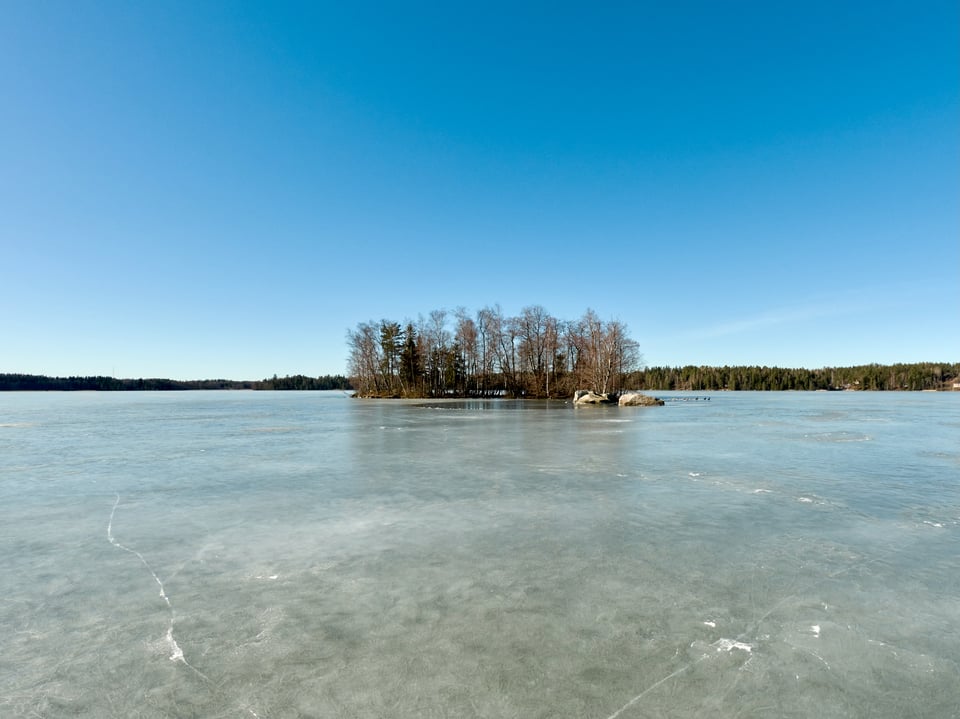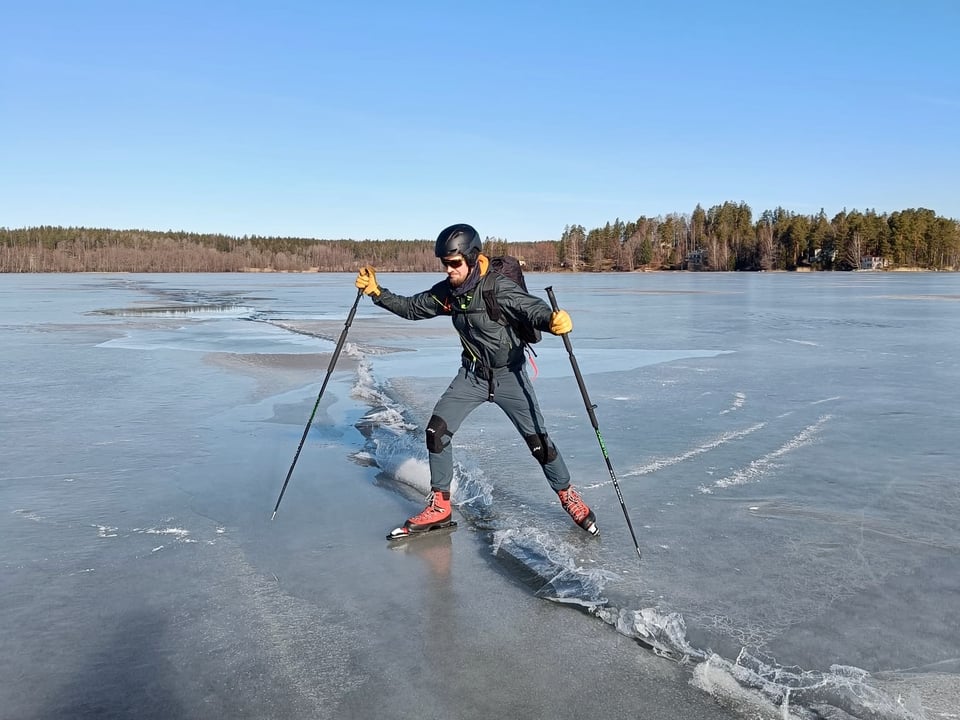My tour skating gear
I'm sharing the tour skating gear I'm using, why I chose it, and how it's going.
Hello hello, in case you have forgotten about me, this is Miikka's outdoors newsletter.
A few months ago I said that the first post on ice safety is coming real soon now. I still haven't finished that post. I want to get unstuck, so let's try something else instead: gear talk.
I'm going to share the list of gear that I use while tour skating. Actually, it's right here on LighterPack. Take a look see the brands and the weights of my gear. The rest of the post is going to be commentary on how I chose the gear and how it has worked.

Skating gear
Skates: Lundhags T-Skate Pro, 50 cm. These are the only tour skates I've ever skated with, so I don't have anything to compare them to. I picked them based on what was available at the local sports store Varuste.net - they were pretty much the only option. As far as skates go, they are fairly long and sturdy, which should make them good on uneven ice. They have worked great so far.
Boots: Alpina Alaska NNN-BC. I chose the boots by trying on all NNN-BC boots at the store and choosing the ones that fit the best. This is the approach I would recommend.
The boots are somewhat waterproof, which I appreciate. For example, I was lakehopping near Lake Meiko in Kirkkonummi and had to walk across a marsh to get to the next lake. The boots did not get wet.
Their biggest downside is that they're heavy at around 1050 g per boot. I would not mind a lighter option for the long days on the ice.
Poles: Zandstra 155 cm. The standard advice is that the poles should be about 0.8 times your height and that's how I chose the poles. Unfortunately they feel too long for me and I often grab them under the handgrip.
The advice is solid if you use the poles to push forward while skating. However, if you have good skating technique, you will use the poles only for inspecting the ice. If you're between the sizes, I'd go for the shorter option.
Or, if you want to keep your options open, consider Pikmakarn's Turbomodel with three different grips in the same pole! And a compass, too!
Backpack: Bonfus Iterus 38 in Dyneema DCF. This pack gets a lot of compliments and it's great that it's pretty much waterproof. That said, I would not buy it specifically for skating. I'd love to have belt pockets for snacks and more attachment points for the throwline.
I've attached an extra strap to be used as a crotch strap in the standard skating harness setup recommended by Suomen retkiluistelijat. The basic idea is that the backpack is used as a buoyancy aid in case you take a plunge. It works better if the backpack does not get too high on your back when you are in the water, and having a crotch strap prevents it.
I haven't otherwise modified the backpack. Sewing DCF seems difficult.
Clothes worn and the spare clothes

It's me in the photo, wearing the skating uniform except that I'm wearing different gloves from the usual. Photo by Joel Kaasinen.
My standard skating uniform consists of a Merino wool base layer, softshell pants and a windbreaker jacket, a tube scarf, and pair of mittens. You can see the brands on the LighterPack.
The uniform has worked great for me when it's around zero degrees Celsius. I haven't bought any clothes for skating except for the skiing mitts. I'm just using whatever I already have for other hobbies. The mitts I bought after multiple trips with cold hands.
The set is optimized for skating. I get cold when I'm standing around, but when I'm moving, it's just about right. I have an insulated jacket in the backpack for the breaks. When it gets a bit colder, like between -5℃ and -10℃, I add a fleece middle layer.
I don't want to spend time on packing and unpacking things, so I just keep the same set of spare clothes packed for the whole winter. They're a bit warmer, a bit more waterproof and a bit roomier than my normal clothes, so they should be just about right. In colder weather, I would need to add a spare fleece midlayer.
Drysacks: I have at least four different brands of drysacks - Ortlieb, Sea to Summit, Mackenzie, Osprey - and they all seem fine. Some are lighter, some are sturdier. I've had them for years for kayak use and none have broken so far. Having sacks in different colors is handy for organization.
Safety gear
As always, remember to practice using your safety gear!
Ice picks: Zandstra. There are multiple similar-looking options on the market. I don't think there's much difference between them.
Throwline: Black Ice 24 m. Again, there are multiple very similar options and it does not really matter which one you get. For the best attachment options, you probably have do it yourself. So far I've just stuffed it in the side pocket of the backpack.
Knee pads: Lundhags foam pads. They warm your knees and make it more comfy to stand on your knee which is convenient when adjusting the skates or the boots.
Helmet: I used a cycling helmet for a long time, but it felt cold and the helmet was not big enough for wearing a beanie under it. I switched to a Julbo ski mountaineering helmet recently and it's much warmer while still fairly light.
Should you use a helmet? There has been a lot of debate without a clear conclusion. One on hand, skaters do fall over every now and then and hit their heads. On the other hand, they usually hit their face and the helmet won't help much.

Tools
Multitool: Okay, I don't know why I have a multitool. It's not usable for adjusting my skates and I haven't ever used it for anything. I'm going to leave it out.
Camera: I'm using a GoPro for still photography. It gives okay result if you edit the RAWs afterwards, although the fisheye lens is tough to work with. I would not recommend it for still photography, but then again, I don't know what I would recommend.
Food and drink
Water bottle: An insulated water bottle is nice to have; otherwise your water will freeze. In colder weather I'll also take an insulated bottle of hot water. It can be used for tea, or for thawing your boots if they freeze after taking a plunge.
Mug: I always have a mug with me in case anyone offers me coffee or hot chocolate.
Snacks: Pirkka Raw Bars are my favorite skating snack bars. Their main ingredient is dates and what makes them good is that they stay pleasantly soft to eat even when they get cold. Mango & cashew is the best flavor.
If there's going to be a lunch break, usually I load an insulated food canister with whatever leftovers I have in the fridge.
The rest
A foam sit pad is a must! Even ultralight hikers carry sit pads as they're so convenient and so light.
Do you need a dry bag for your phone? I don't know. The current-day mobile phones are by and large waterproof. However, I don't know what happens if you dip one into water in freezing weather.
What's missing?
I could be better prepared for accidents:
- My first aid kid is missing a sturdy emergency blanket. It could come handy if you need to move an injured person after an accident. At least one person in a group should have a blanket, but since I skate with multiple groups of people, it'd be easiest to just always take it.
- I don't have much anything for fixing broken skates or boots. I've heard from multiple people about the soles of their boots falling off. Straps could be used to hold the boot together until you get back to the shore. And what about breaking or losing a skate? That happens, too. A group should have a spare skate if they're venturing far out.
Having an ice saw would be interesting for inspecting the ice. Do I have anything extra? Apart from the multitool, not really.
I'm pretty happy with my gear. Making the list triggered my ultralight instincts and I can see a few places to save grams. Whether it's worth the €/g, I don't know.